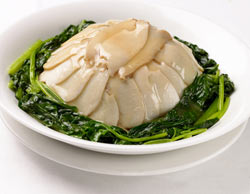About abalone
Two native abalone species, Greenlip abalone (Haliotis laevigata) and Blacklip abalone (Haliotis rubra) are being farmed in southern Australia. The two species have also been mated to produce the hybrid tiger abalone (Haliotis laevigata x rubra).
Abalone is found along the rocky shores of Australia, south from mid New South Wales down and around to Western Australia. Blacklip abalone can grow to at least 21cm in length.
Abalone are marine molluscs (sea snails) found on reef areas close to the shores of oceans that lie between the tropics and the arctic circles. The protective shell has a row of respiratory pores along the spiral that allows water to enter their bodies and provide oxygen for the gills for absorption and for to allow wastes to be flushed out. Inside the mouth is a file-like tongue which scrapes algae from rocks to a size that can be swallowed. The internal organs of abalone are arranged spirally under the shell. The gill chamber is under the respiratory pores and next to the mouth.
An abalone has a head, a pair of eyes, a mouth and a large pair of tentacles.Abalone use their muscular foot to attach themselves firmly to rocks . The foot is surrounded by a frill. Extensions of the foot containing small, tentacles and sensory structures.
Abalone are grazing animals, eating marine algae. The adults feed on loose pieces of algae drifting with the currents. Large brown algae such as giant kelp and bull kelp are preferred, although most types of algae may be eaten. Abalone tend to stay in one location waiting for food to drift by. Juvenile abalone graze on rock encrusting coralline algae and on diatoms and bacterial films. As they grow they increasingly rely on drift algae.
Abalone's predators are crabs, starfish, stingrays, wobbegong sharks and possibly rock lobsters.
Spawning usually occurs during the summer months. It may be caused by increased water temperature, high wave action or extreme weather conditions, day length, the phases of the moon and the presence of abalone gametes. Females eject eggs into the water through the respiratory pores, this causes males to eject sperm in the same way and the eggs are fertilized in the water.
|
It is c onsideredto be a delicacy by many people. It has a smooth texture that is
strongly desired by communities in Asia to promote longevity and good health.t being too firm, with a very mild bitter taste. Abalone need to be cooked very quickly or for a long time to ensure that it is tender.
The abalone is usually cut into small fillets tenderisedby hitting it with a mallet a few times and often marinated before it is quickly fried. |

|
|
|